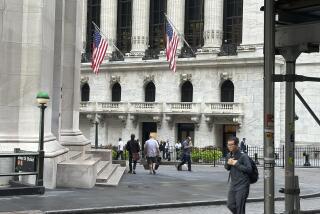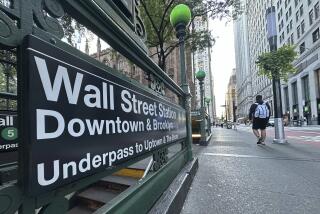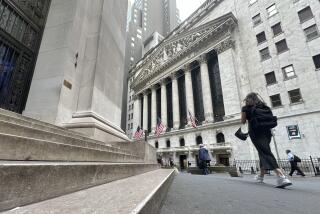Staggering Dow falls 733 points
- Share via
Remember that 936-point gain in the Dow Jones industrial average Monday? It’s now mostly gone.
On Wednesday, fear that the U.S. and other nations are sliding into a severe recession trumped investor relief over the banking system bailout, sending the Dow down 733 points. The sell-off came after grim retail-sales data stoked worries that the economy might be contracting, threatening to crush corporate earnings.
The nearly 8% plunge pushed the Dow back below the 9,000 level, leaving only a 126-point gain in the index for the week. It also damped hopes that the government’s plan to inject capital directly into the faltering banking system would brake the brutal stock selling on Wall Street, where the Dow suffered its worst week ever last week.
“The stock market had already priced in a recession, but now we’re seeing fears of a deep, long-lasting recession or even a depression,” said Gary Wedbush, head of capital markets at Wedbush Morgan Securities in Los Angeles.
There are already signs that the slumping economy is taking a bite out of corporate earnings. That could foretell further declines in the stock market, which is hypersensitive to corporate profit reports.
“We’re seeing an across-the-board collapse in earnings expectations,” said Dirk van Dijk, director of research at Zacks Investment Research in Chicago.
In the last four weeks, he noted, analysts covering companies in the Standard & Poor’s 500 index have issued more than five downward earnings revisions for 2008 or 2009 for every upward revision. Analysts, who as of last Thursday had expected this year’s overall profits to slide 2.7% from 2007, now predict a 4.1% drop.
“It’s clear that we’re in for a good old-fashioned, long-lasting, nasty recession that’s going to put a lot of people out of work and inflict a lot of pain,” Van Dijk said. “This is going to be like the mid-1970s or the early ‘80s -- not like the early ‘90s or 2000-2002.”
Stocks began to slide after the government reported early in the day that retail sales slumped 1.2% in September -- far worse than the 0.7% decline that economists had expected.
The downswing accelerated as the session wore on despite Federal Reserve Chairman Ben S. Bernanke’s hints during a luncheon speech to the Economic Club of New York that further interest rate cuts could be in the offing. Investors may have been focusing more on Bernanke’s comment that even with the massive financial rescue plan launched by governments around the world, a “broader economic recovery will not happen right away.”
In addition, the Fed’s latest “beige book” snapshot of business conditions around the nation -- released shortly after Bernanke’s speech -- showed the economy continued to lose traction in the early fall, reflecting mounting damage as financial and credit problems deepened. Economic activity weakened across all of the Fed’s 12 regional districts.
Some analysts said more than economic concerns were driving down stocks. Don Hodges, who runs the Hodges mutual fund in Dallas, said that “forced liquidations” by fund managers were hurting the market even more than the public’s reaction to the bad economic news.
Heavy redemptions from beleaguered investors at hedge funds and mutual funds, he said, have forced money managers to raise cash by dumping stocks that were already selling at depressed prices.
“It’s like being in a movie house when someone hollers ‘Fire!’ ” Hodges said. “Everyone is just trying to get out that door, and investment managers are having to sell stocks they don’t want to.”
The Dow closed at 8,577.91, down 733.08 points, or 7.9% -- its 12th-largest one-day percentage drop and the biggest since Oct. 26, 1987. The broader Standard & Poor’s 500 index fared even worse, losing 90.17 points, or 9%, to 907.84. The tech-heavy Nasdaq composite index slumped 150.68 points, or 8.5%, to 1,628.33.
Losing stocks led winners 9 to 1 on the New York Stock Exchange. Volume was relatively moderate, however.
The Dow has risen only one day this month, and is down 39.4% from the all-time high of 14,164.53 that it hit last October. The Nasdaq is at a five-year low after falling below last week’s nadir, and the Dow and S&P; 500 are closing in on the same dismal milestone. Analysts said that if the Dow and S&P; 500 pierce last week’s lows, spooked investors could send the market on another downward spiral.
All 10 industry sectors of the S&P; 500 were down for the day, led by energy stocks, which were hit by another decline in oil prices. Crude fell $4.09 to $74.54 a barrel. Oil giants Exxon Mobil and Chevron fell 14% and 12%, respectively.
Retail stocks were hit hard, with Macy’s tumbling 17.5% and Target falling 10%.
Credit card firms also retreated on fears of reduced consumer spending. Visa lost 14% and American Express dropped 13%.
Profit warnings or dismal earnings reports walloped stocks across a range of industries, including Jones Apparel Group, which dived 30%; chip maker Linear Technology, which skidded 15%; brokerage Piper Jaffray, which sagged 20%; and Callaway Golf, which dropped 20%.
The yield on three-month loans between banks eased to 4.55%, from 4.64% on Tuesday, the fourth straight daily drop and an indication that the credit markets may be thawing a bit. However, the yield on the three-month Treasury bill fell, a sign that investors were still hoarding cash.
Wednesday’s dive in New York was preceded by sell-offs in most major world markets. Stocks were down 5% in Hong Kong, 6.5% in Germany, 7.2% in Britain and 14.4% in Brazil.
--
More to Read
Inside the business of entertainment
The Wide Shot brings you news, analysis and insights on everything from streaming wars to production — and what it all means for the future.
You may occasionally receive promotional content from the Los Angeles Times.










